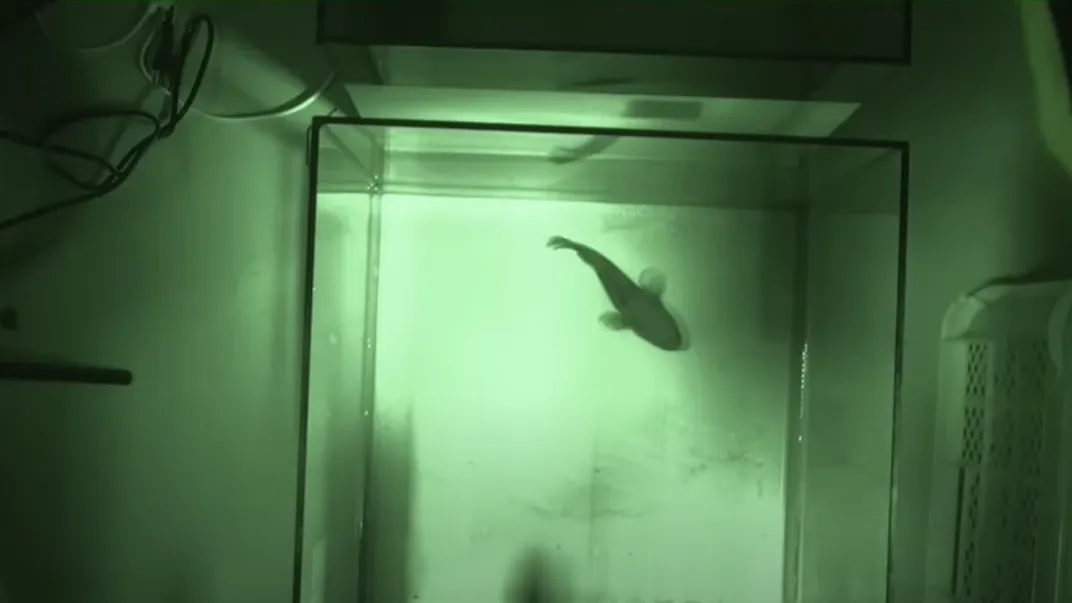Watch Eels Make a Great Escape From a Fish’s Stomach After Being Swallowed Alive
For the first time, scientists witnessed Japanese eels free themselves from the stomach of a predatory fish in X-ray video footage
:focal(250x167:251x168)/https://tf-cmsv2-smithsonianmag-media.s3.amazonaws.com/filer_public/79/e9/79e90ab9-edbb-4f1a-94f1-8dd50d1db476/eel_image.jpeg)
Prey animals have evolved many ways to escape being eaten by a predator. Some flee with speed, while others hide using mimicry. But for Japanese eels, escape means wiggling out tail-first from the stomach of a fish.
In a new study published in Current Biology on Monday, researchers from Nagasaki University in Japan filmed as juvenile Japanese eels (Anguilla japonica) escaped from the stomach of a dark sleeper fish after they had been swallowed alive. The eels moved back up the fish’s esophagus and pulled free through its gills. In an earlier study, the researchers had found that Japanese eels could escape the predator’s capture, but they didn’t know how.
“We had no understanding of their escape routes and behavioral patterns during the escape, because it occurred inside the predator’s body,” says lead author Yuha Hasegawa, a behavioral ecologist at Nagasaki University, in a statement.
This time, the researchers used an X-ray video device to see inside the predatory dark sleeper fish (Odontobutis obscura). They injected a contrast agent into the eels that made them visible with the device, even after they were eaten.
Over the course of a year, the researchers recorded 32 eels being captured by the fish, with at least part of their bodies entering the predator’s stomach. Of those eels, 28 tried to escape. Thirteen were able to push their tails out of the gills, and nine successfully emerged from the fish. Two eels failed because they poked their tails toward the fish’s vent, which is used for removing waste and water, rather than toward the esophagus.
Time is of the essence for the escape-artist eels, since they can only spend around three minutes inside the dark sleeper’s stomach before dying. Those that wriggled free of the fish managed to do so in an average of 56 seconds.
“The predatory fish were not harmed. However, the eels that managed to escape sometimes showed signs of abrasions,” Hasegawa tells the Guardian’s Nicola Davis.
These movements, however, are common and normal for the eels. “Burrowing and swimming backward are both natural behaviors,” says study co-author Yuuki Kawabata, a behavioral ecologist at Nagasaki University, to the New York Times’ Annie Roth. In a way, the eels are built for these escapes.
For Kawabata, “the most surprising moment in this study was when we observed the first footage of eels escaping by going back up the digestive tract toward the gill of the predatory fish,” he says in the statement. At the beginning of the experiment, they thought the eels would escape by moving from the fish’s mouth to the gills. What was astonishing was witnessing the eel move from the stomach to the gills, he adds.
Kory Evans, a fish biologist at Rice University who was not involved in the study, tells the New York Times the escape is an impressive feat. He notes that the fish’s gills tend to have obstacles such as bony arches that make it harder for eels to escape. “Oftentimes, fish have teeth on their gill surfaces, so slipping past that can be quite a challenge.”
To Evans, the study was also “another reminder that eels are really cool.”
The team now plans to look into other eel species that might use the same technique. They want to observe specific factors that make that escape possible, such as body shape. And down the line, they might even explore whether Japanese eels make the same daring departure when eaten by other predatory species.
“At this point,” Hasegawa tells New Scientist’s Michael Le Page, “the Japanese eel is the only species of fish confirmed to be able to escape from the digestive tract of the predatory fish after being captured.”
/https://tf-cmsv2-smithsonianmag-media.s3.amazonaws.com/accounts/headshot/headshot_2_thumbnail.png)



/https://tf-cmsv2-smithsonianmag-media.s3.amazonaws.com/accounts/headshot/headshot_2_thumbnail.png)